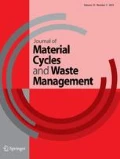Abstract
Coffee residue is usually regarded as a kind of agriculture waste; as its quantity increases the treatment of coffee residue will become an environmental problem. This research is innovative in that it derives the possibility of recycle application using coffee residue ash for cement replacement. In this research, coffee residue is burned in an electronic oven to three kinds of coffee residue ash at 500, 600 and 700 °C, and then appropriate apparatus is used to check the chemical and physical properties of these three types of coffee residue ash. After a general comparison, this study selected 500 and 600 °C coffee residue ashes with 2, 3, 5, 10 and 15 % cement replacements to make 5 cm3 cube mortar specimen to test different curing ages’ compressive strength. Through measurement and experiment, this research found that the compressive strength decreased by adding 500 or 600 °C coffee residue ash into the mortar. By considering waste reduction and practice application, this research derives that using the 600 °C coffee residue ash with 10 % replacement is better than others application, such using result also can get valuable efficiencies of financial and CO2 reduction.












Similar content being viewed by others
References
Environmental Protection Administration Executive Yuan, R.O.C. (2010) http://www.epa.gov.tw/. Accessed 15 Dec 2010
Hwang CL (2006) Quality control test of concrete material. Chan’s Arch-Publishing Co. Ltd., Taipei
Hong YH (2006) Investigation on pyrolysis characteristics of coffee residue by physical process. Master Thesis, Fooyin University, Department of Environmental Engineering and Science, Pindon
Lin LK, Yu SI (2010) The possibility research of applying coffee residue into concrete material. J Taiwan Environ Eng Assoc 21(2):1–14
Hsu YS (2010) The application of coffee residue ash as into concrete metrical. Master Thesis, National Taipei University of Technology, Institute of Civil and Disaster Prevention, Taipei
Wen XF, Luo QM, Hu HL et al (2014) Comparison research on waste classification between China and the EU, Japan, and the USA. J Mater Cycles Waste Manag 16:321–334
Stelmachowski M (2014) Feedstock recycling of waste polymers by thermal cracking in molten metal: thermodynamic analysis. J Mater Cycles Waste Manag 16:211–218
United States Environmental Protection Agency (2009) Sustainable materials management: the road ahead 2020. EPA530R09009, USA
Ghuzlan K, Al-Khateeb G, Damrah AA (2013) Using oil shale ash waste as a modifier for asphalt binders. J Mater Cycles Waste Manag 15:522–529
Hwang CL (2009) Design and application of high-performance concrete. Scientific and Technical Publishing Co. Ltd, Taipei
Wu WS (2010) Properties research of rice husk ash concrete. Master Thesis, National Taipei University of Technology, Institute of Civil and Disaster Prevention, Taipei
Siddique R (2008) Waste material and by-products in concrete, pp. 235–264
Metha PK, Pirtz D (1978) Use of rice husk ash to reduce temperature in high strength mass concrete. ACI J 75:60–63
Hwang CL (2005) Quality assurance of ecological concrete material. Chan’s Arch-Publishing Co. LTD., Taipei
Salas A, Delvasto S, de Gutierrez RM, Lange D (2009) Comparison of two processes for treating RHA for use in high performance concrete. Cem Concr Res 39:773–778
Shen GF (2003) Concrete quality control. Wenhsin Press, Taipei
Taiwan Coffee Association (2010) http://www.taiwancoffee.org/info.asp. Accessed 25 Oct 2010
Wang SY (2001) Environmental effect of wood materials by strengthen CO2. J Wood Struct 8(3):6–17
Author information
Authors and Affiliations
Corresponding author
Rights and permissions
About this article
Cite this article
Lin, LK., Kuo, TM. & Hsu, YS. The application and evaluation research of coffee residue ash into mortar. J Mater Cycles Waste Manag 18, 541–551 (2016). https://doi.org/10.1007/s10163-015-0351-5
Received:
Accepted:
Published:
Issue Date:
DOI: https://doi.org/10.1007/s10163-015-0351-5




